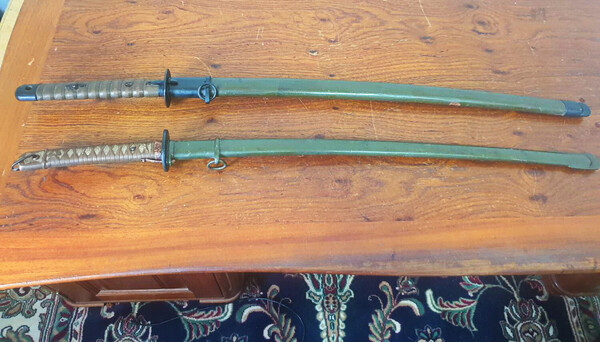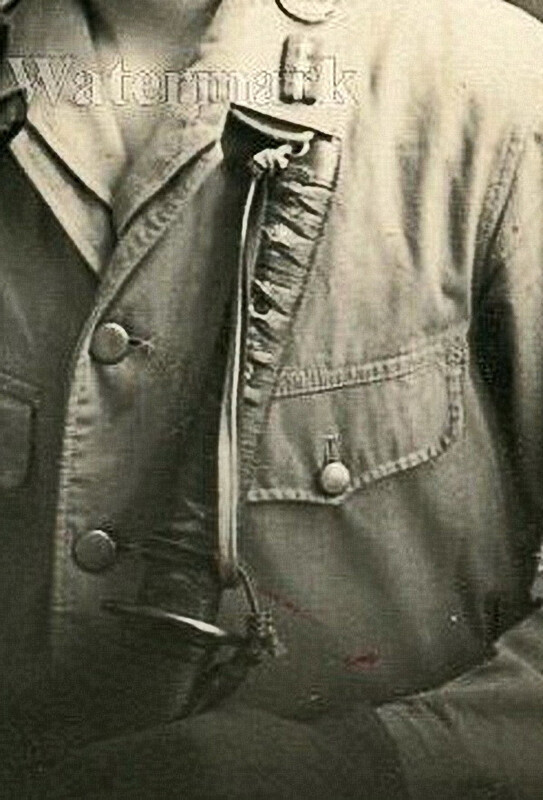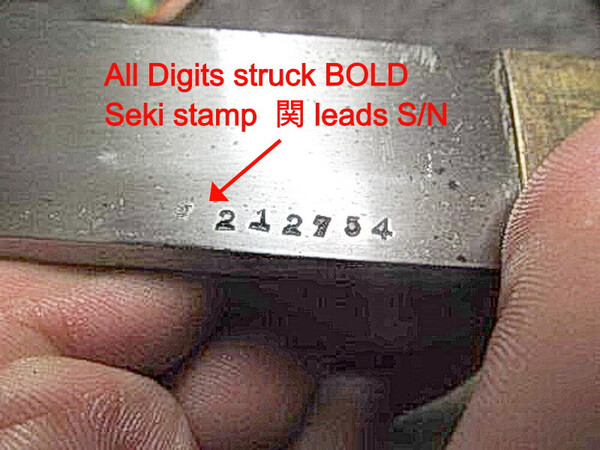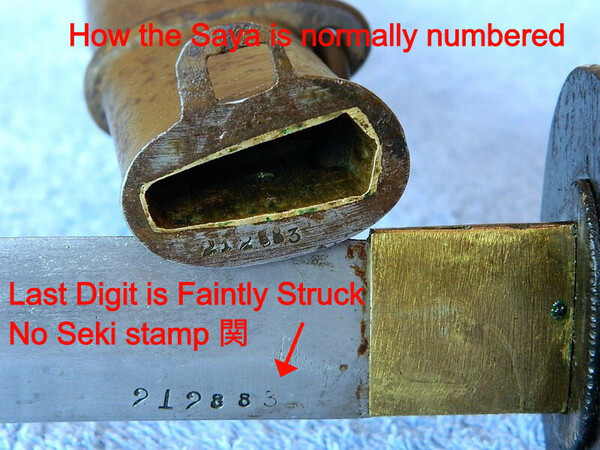-
Posts
418 -
Joined
-
Last visited
-
Days Won
8
Content Type
Profiles
Forums
Events
Store
Downloads
Gallery
Posts posted by Stegel
-
-
-
21 hours ago, Kiipu said:
Is that atypical for the Pattern 7 handle to be painted olive like that?
I'm sure you'll find the handle itself is not painted, they are usually raw wood or with a varnish coat. When used and worn they have a stained look to them.
The scabbards can vary in paint colour, from the OD green to brown, i have one in a grey also.
i have re-posted the first picture in the OP, with slight adjustment to colour and vibrance, you can see the handle is not painted.
-
 1
1
-
 2
2
-
-
-
-
I agree with Kippu and Bruce on this one, Blade has been cleaned and last digit being faintly struck, was removed.
A nicer picture Cliff, sharper and higher resolution in better lighting would help further.
I have added some examples from the serial number range which we suspect your sword is from, and there are some with the last digit being very faintly struck for you to see.
The scabbard is the first that i have seen with 2 digits, i have seen them with 3 and the orientation of the numbers is correct, however the blades are all in the 300k range. BangBangSan has a few aswell, i tried to find the thread where he posted but had no luck.
So i believe the sword is a Pattern 5, with the last digit of the serial number missing (possibly to over polishing in the past), the scabbard i tend to think is mismatched with another from the 300k serial range, just prior to the introduction of the Pattern 6 version from the Jinsen Arsenal. These have wooden scabbards which are not numbered, and the handle although appearing similar, is more thicker and larger.
BTW- Geoff, please post some clear photos of your swords numbers, 5 digits doesn't sound right to me at the moment.-
 1
1
-
 1
1
-
-
10 hours ago, Misconstrued said:
I heard late war guntos like these are more rare and collectible, I never do plan on selling the sword ever, but how rare and collectible is this gunto?
These Jinsen Arsenal swords were made in the last few months of the war before its end in August 1945.
To date i have only seen them in the serial number range of 300k to 302k, so only some 2000 were actually made if you go by that.
So they are 'rarer' than the more highly prized (and priced) 1st Pattern Copper Handled version, where some 6500 were only made.
-
 1
1
-
-
Thanks for some better photo's JR after your last post.
This is the 6th distinctive pattern of the type 95 model.
As Thomas said made by the Jinsen Arsenal, not Nagoya, and i agree with him that the stampings are correct.
It differs to the previous pattern by having the serial numbers in the 300k range, instead of the 200k range.
The knurled/ cross hatch handle is also more bulkier than before, with more finer knurling . With this pattern, it is the first time we get to see the wooden scabbard which was the replacement for the metal ones.
You will not find any serial numbers on the scabbard, for some reason this practice was discontinued with this model, so only on the blade itself.
The next two patterns only had the arsenal inspection stamps and NO serial numbers on the blade, as well as the scabbard.
Looking at yours, it does appear to be a bit messy, however over-stamping was common on these, especially with the first digit, 3 over the 1.
If you get a chance and get a good look, you should find more inspection stamps on both the scabbard and sword fittings. (ヘ) and maybe get a nice sharp picture of the serial number itself.
As Rob and Bruce also mentioned, there is not much to see under the handle if you remove it, and there is a good chance it may not go back together nice and tight again, i personally would leave it alone, especially since it appears to be a family heirloom of yours.
You will never get these 'papered' as they are all machine made, not traditional, so 'nihonto' experts will not be able to tell you much more.
-
 2
2
-
 2
2
-
-
It is a late war NCO sword, from what I can tell, Pattern 6 wooden handle with wooden scabbard. Serial numbers start at the 300k mark for these. They are not very common and desirable for collectors of Type 95 swords.
Please post some clearer photos here,
you will find more info in other threads on this forum and also over at the warrelics forum.
-
From what I can see, I believe it to be a polish replica
-
 1
1
-
 1
1
-
-
Great work BangBangSan!
The seller of the original was initially asking $1200 back in October.
The Handle came from this sale, https://www.ebay.com/itm/WW2-Japanese-NCO-OFFICERS-Katana-SWORD-No-Scabbard-War-Bring-Back-Make-Offer-/274683036317?hash=item3ff462829d%3Ag%3AZDgAAOSwB1RgKJA4&nma=true&si=Fqt8v0ReL%2FgRvp7smL77g14iJXI%3D&orig_cvip=true&nordt=true&rt=nc&_trksid=p2047675.l2557
Now the monkey is also selling on the bare blade after stripping the handle. https://www.ebay.com/itm/wwII-Japanese-Army-officer-NCO-SWORD-blade-only/114737303547?hash=item1ab6e04ffb:g:XcIAAOSwoOVgWUEy
-
 3
3
-
 1
1
-
-
1 hour ago, Bruce Pennington said:
Ha! I just had a thought - what if the nut is upside down? There is only one way to know..........
+1
Exactly my thought too Bruce.
-
Welcome Elco,
You are right in it being a legitimate Nagoya Arsenal sword.
It is the 'Rinji' pattern, that is due to demand for metals such as Copper and Brass for other areas in the war effort, the Brass guard (tsuba) was replaced with a plain round steel version, as were the washers and screws and tassel ring.
Some came out with the copper collar (fuchi) where the Arsenal and Contractor stamps are placed, yours, had this also changed with a steel one.
Due to the hardness of the steel, it caused issues with the stamping process, some are faintly seen, but generally the stamping was omitted on these versions.
As it has the Locking mechanism at the Top of the handle, it is the third pattern in the type 95 range.
It was made under the Kokura Administration of Arsenals for Sword Production, so before 1942.
After this time, each Arsenal was in charge of its own production with their own allotted serial number ranges.
As a general guide i would place it being made about April/May 1942.
Not long after, when Nagoya was under self Administration, it changed to the Side locking mechanism and began producing only this variant. ( firstly Aluminium Handles , then the wooden 'pineapple' Handled swords- all side locking)
I looked into the 'nut' for the screw in the handle, and yes it looked a bit odd to me at first also, but having checked on other swords of the same variation (steel screw/nut), in the same serial number range, i can confirm it is also legit.
Overall it is a nice example and you should have nothing to worry about.
You can find more information on these at Ohmura's Web page here: http://ohmura-study.net/957.html It will give you a good primer on these and many other models.
-
 1
1
-
 1
1
-
-
The brown i see at the drag is what i believe to be 'rust'. It hasn't been confirmed as paint or anything else at the moment. I DID NOT see Brown paint.
Here i will quote myself from post#3, where i was asking the question:On 3/16/2021 at 3:43 PM, Stegel said:I can't tell from your photos but does there appear to be any different paint under the rather rough appearing black ?
The drag looks like it has a coating of rust, with perhaps some remains of a brown??
Clifford is lucky in having providence via family history and has confirmed that the sword had a black saya from about 1949/50. This is from his Mothers recollections.
Now Three possibilities exist:
1-Genuine Black saya from Arsenal.
2-Period War repaint, either at Arsenal, or in the Field of battle (which is generally more obvious as such.)
3-Post War repaint - (upto 1949/50)possibly done by his grandfather for reasons unknown, but not a common practice so soon after the war i would think, but not unreasonable.
Not one of these has yet been proven, but more to the point, neither have any been disproven.Now with the question of Black paint being used on Scabbards.
Firstly it was used on the type32 production, and is found on Type98 and 97's, so why is it a definite NO for type95's?????Now i know everyone has a view on this, but in fairness lets be honest and not misquote to further our cause.
On 3/16/2021 at 6:36 PM, Shamsy said:Nick was very clear that black was never an approved colour for 95s and cannot find mention in any archival records of it being officially allowed, hence why I think it was a field emergency measure and not part of production or refurbishment.
I have yet to see any real evidence that the sayas ever started out black, while I find more examples of repainted but period black saya.
I don't mind at all if anyone disagrees with my theory. It's only a theory after all. I'll continue to add examples to my thread when I find them (and try not be be slack about it).
Here's the 1943 weapons Camouflage manual thread posted by Nick at Warrelics, which is the main source of this:
Japanese-armys-1943-weapons-camouflage-manual
In post #10, i asked about black being used for camouflage purposes, his response in post#11 was NO, the manual denies this possibility, but this is in reference to 'Camouflage' only.
This statement rather only denies possibility 2 -in the field, at the time of the manuals release. The option of an Arsenal produced black scabbard is not part of the scope of the document.Then in relation to provisional launch documentation of 1935, he only uncovered that issues existed with the actual paint finish itself (black was not specified here) The level of Gloss and general paint durability inparticular, made them think about scabbard covers as an alternative solution, and he goes on to say-'
QuoteSo the development mandate for the scabbard paint was a matte finish that was durable.
Glossy black would have been out of the question at that time.This is in 1935.
Yet observations of type 95 swords (which began production in 1937, 2yrs after the initial mandate) show that the Tokyo Arsenal, used a matte black whereas, Nagoya after 1943 had used a gloss black in some limited production, both used other colors of course. These observations include all three of the possibilities mentioned prior.
Nagoya's use of Gloss, contradicts the manual, however, it's worth noting that one is a production environment, while the other being the manual, refers to the field environment with camouflage only in mind.
It's also worth noting that Option 3 - post war repaint, particularly one which targets Nagoya swords ONLY, is highly unlikely.Care must be taken not have a conclusion by hand picking data which suits, but to consider all data before making any conclusions.
Back to the original sword in this post.
The texture of the paint is interesting and understandable now.
If it is not too much trouble Clifford, could you please post some close up photos of the scabbard drag, its sides and around the throat/hanger area please.
A great piece of family history you have!-
 1
1
-
-
Yes, good call on the date, i put it at April 1940.
Have a read of the link Bruce gave you, it should get you familiarised with this model.
I can't tell from your photos but does there appear to be any different paint under the rather rough appearing black ?
The drag looks like it has a coating of rust, with perhaps some remains of a brown??
-
Maybe expand your board and include a Kai Gunto so you’ve also got Navy involved.
it really depends on whether or not you’re happy with a representative from each area or you could go deeper into a specific one such as the NCO”s for example.
Also I believe the Japanese way of displaying them is with the handles at the left. More of a peace time non aggressive thing, as it makes it harder for you to grab one out and start Slicing away!
Nice collection.
-
 4
4
-
-
9 hours ago, waren said:
please tell me the approximate year of releaseI place it at about February 1940
-
 1
1
-
-
OK, Thanks Bruce.
It was just a thought at the time of seeing it.
-
 1
1
-
-
Just saw this thread and had a thought.
It looks like the blade shown as the modified type95 (from type 32)
Are you able to get some dimensions on this? (width, thickness, bohi and it's position to the mune)
-
 1
1
-
-
I was auto logged off....
this part is missing:
Read it as the third last paragraph in my reply please.
QuoteThat's the two best case scenario's, ......now the last is the obvious Post War repair. Obviously not done by 'Bubba' , -but someone more skilled and knowledgable.
Having said this, i do find it odd that you have a black steel screw with a rather large diameter(most unusual), larger than any i have observed and a brass nut holding it in place. This is a first for me that i can think of, and makes me lean towards the Post war repair for now (mainly because of the screw diameter). I'll keep looking to see if i come across any others like this.
-
Chris,
I'm sorry, i'm afraid that i have misled you earlier with the date i gave, I thought i could trust my memory but as i'm geting a bit long in the tooth, i should keep my mouth closed and check first!
I've had a chance to check the date range and can say it was made in fiscal year of 1941, not 1940. About Mid 1941 to be more accurate.
Checking my records has shown nothing from this contractor in this range, so your's is the first for me. Iijima had a production run before, and after yours.
Normally you find the black screws come along with the black collars (Fuchi), and brass screws with the copper/brown fuchi's on which the Arsenal stampings are visible ( this is true for both brass and steel tsuba's/guards)
All of the Iijima swords at that range, have the Brass screw fitted, but as the Rinji Specs (plain steel black tsuba/guards and fuchi/collars) have been made a long time prior to yours, it isn't unreasonable to think that perhaps it was assembled this way, especially if they were running short on parts.
It is also reasonable to assume that this may have been a repair, possibly out in the field of combat, as the brass screws are known to have a tendency to shear and break easily. (especially the early ones)
Having said this, i do find it odd that you have a black steel screw with a rather large diameter(most unusual), larger than any i have observed and a brass nut holding it in place. This is a first for me that i can think of.
I'll keep looking to see if i come across any others like this.
For now, i wouldn't worry too much as overall, it is a very nice sword, and i really like the darker 'jungle' green coloured scabbard, it isn't a very common one to come across as most are the usual drab olive brown.
-
 1
1
-
-
Nice sword and welcome to the Japanese side of collecting!
The ‘2’ is the correct font used by this contractor in the serial number range you have.
the ‘4’ is also normal
-
Nice sword.
i agree with the 1940 , however I would say it’s the fiscal year 1940 which includes he first quarter of 1941.
i would be confident in saying Feb/Mar 1941 as the serial number is right at the end of the years production.
The screw does appear to be a bit odd, so I’ll check with other swords in the same range from the same sub-contractor
-
 2
2
-
-
Nice group Hamish, also the one on sale appears very nice.
-
Hello Dave,
You have a lovely example there, the serial numbers tell me it is early 1941 manufacture, and as Bruce indicated it is the later (not earlier- earlier used 'K' not '-') Kobe subcontractor who made it.
This contractor is known to have used the 'greenish' paint on the handle as well as the more commonly seen brown.
Measure the tsuba, as it should only be the 9mm variant at that stage of production. The 11mm were only for the Copper handled and the very early Aluminium until stock ran out. (a few years before yours was made)
The serial numbers for this model will only appear on the blade itself, and the scabbard throat. (whereas the drag is stamped on the type 32's instead of the throat).
From your pictures, I would consider this to be an excellent to near mint example, with a bonus original tassel... very nice find. Definitely not a Chinese copy or otherwise repainted.
Judging by today's market, i would think this one would easily go for over the $1000 mark -due to it's condition, so i hope you picked it up cheap!
And finally, yes they are reasonably Well made, i agree with Bruce and Trystan, the Tokyo Arsenal made Type 95's are cleaner and crisper overall compared to the Nagoya and later Jinsen made swords.
Congratulations and check out the link Trystan gave you for more info on these in general.
-
 1
1
-
 2
2
-
















Attention Mantetsu Owners: A Survey
in Military Swords of Japan
Posted
Neil And Bruce,
A great summary of the subject.
This thread has been thoroughly enjoyable to read and follow.
Thanks to all for the hard investigative work! (You all know who you are)